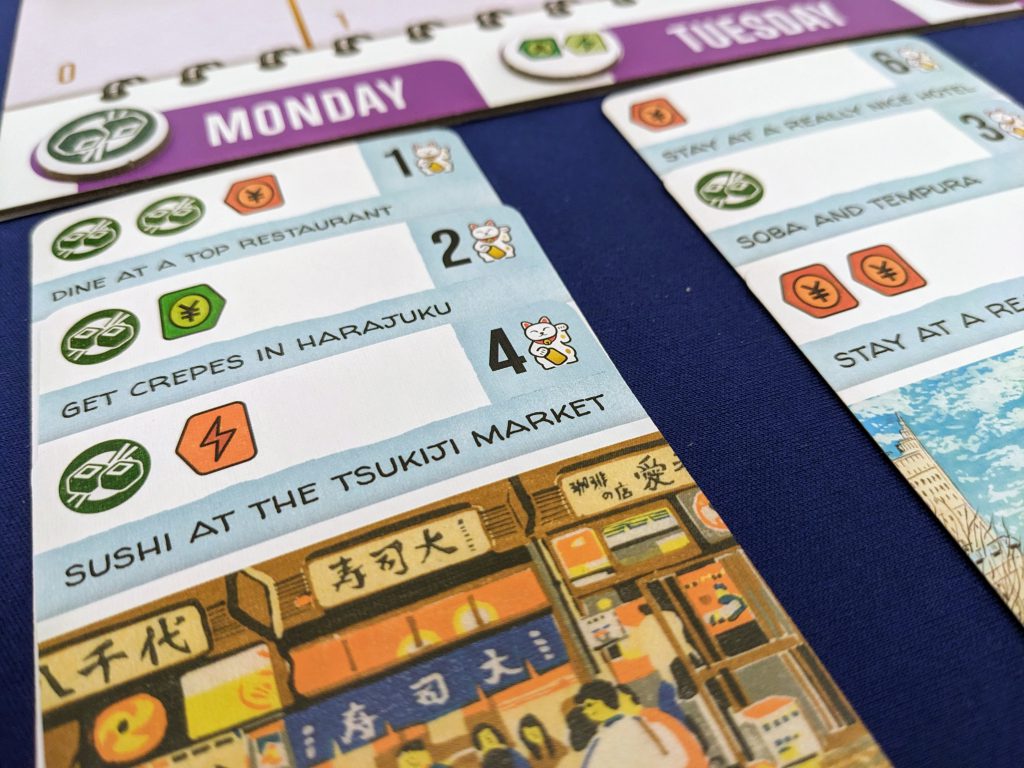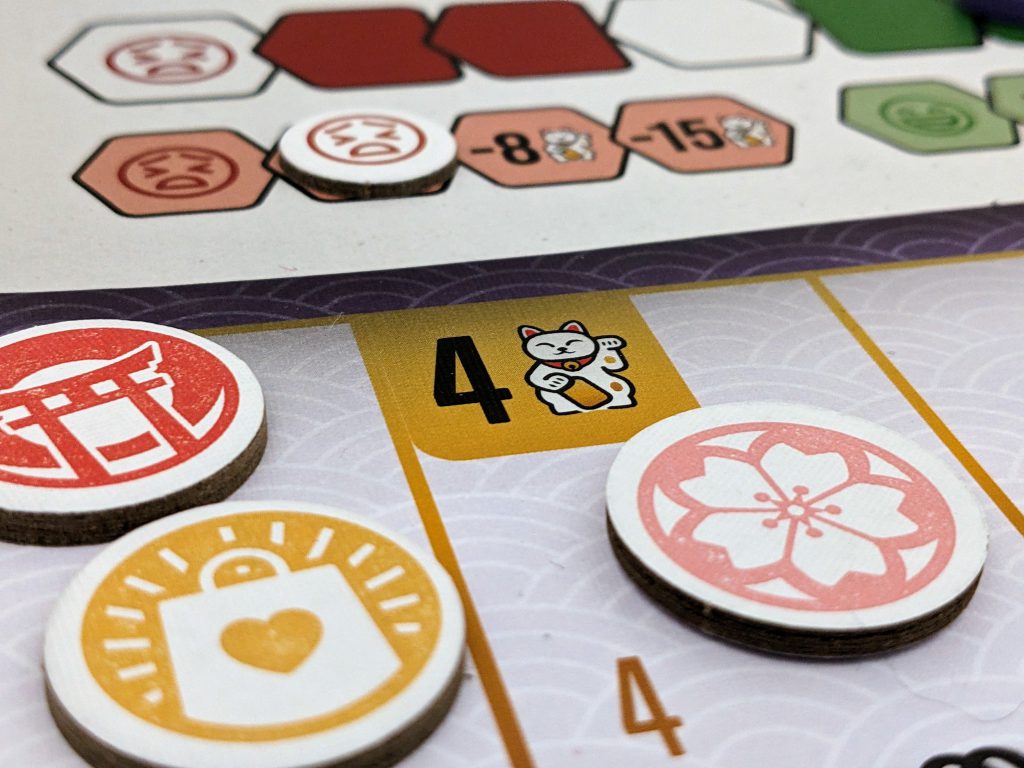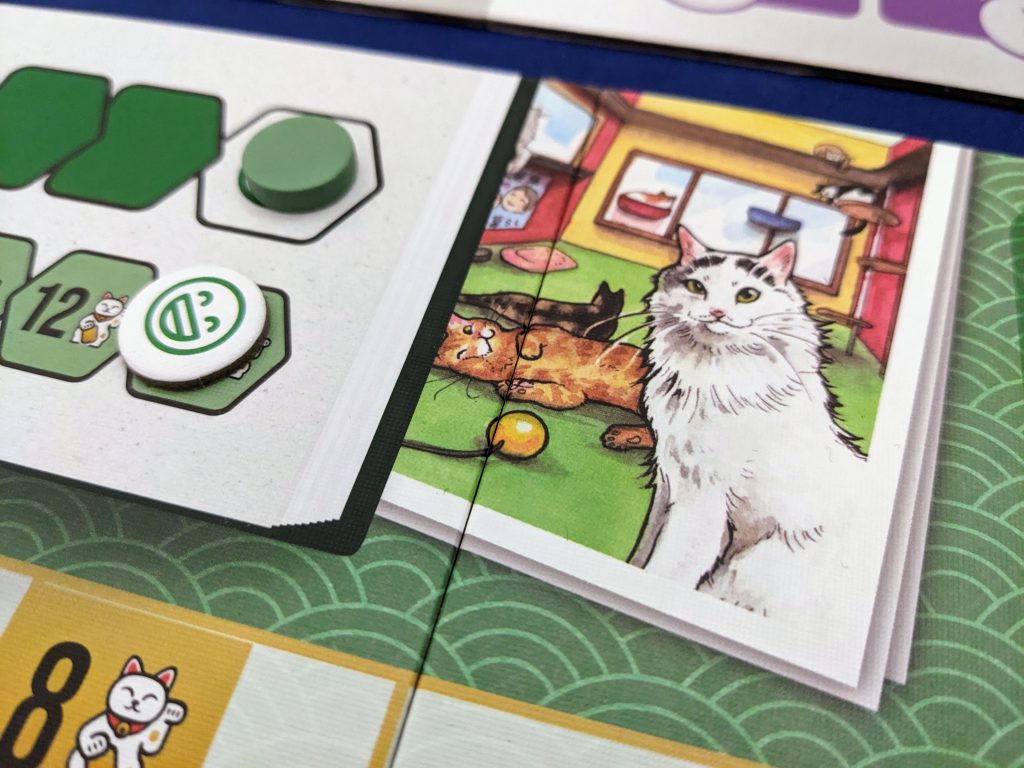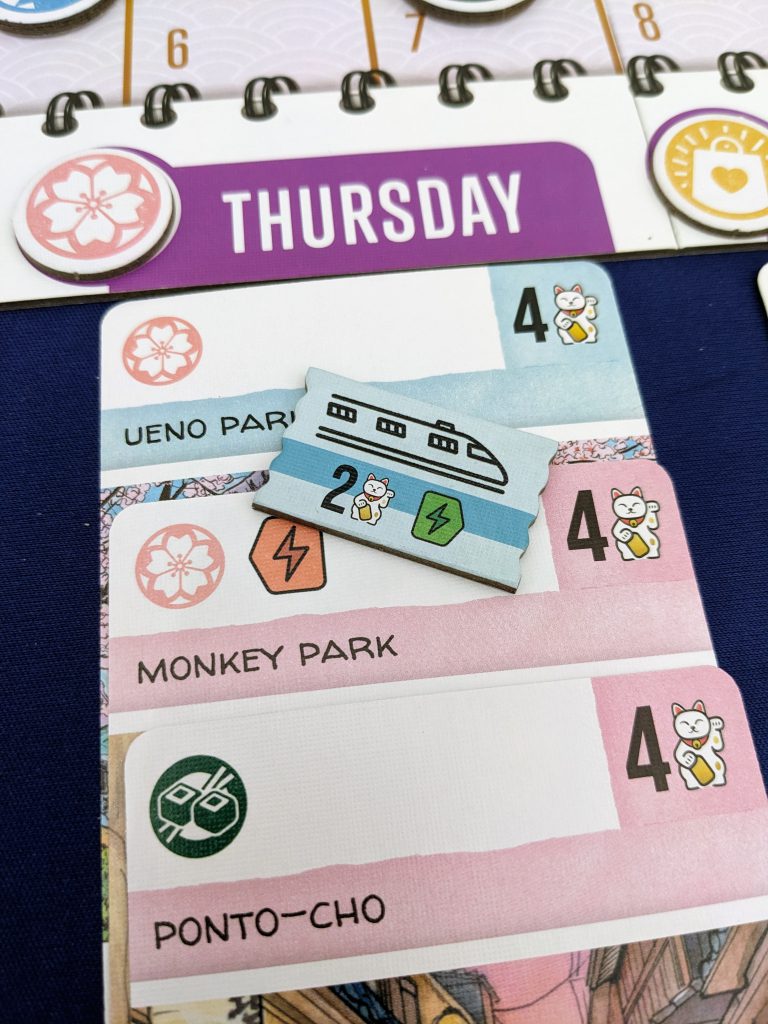I knew I’d love Let’s Go! To Japan before I even opened the box. Not only because designer Josh Wood made Cat Lady expressly for me, a cat lady. Not only because he designed Santa Monica expressly for me, a beach bum who hasn’t been to Santa Monica but who digs tableau-building, Tarot-sized card games.
Let’s Go! To Japan was an automatic slam dunk because not only do I love to travel, I loooooove planning trips. I love logistics the way that Danny Ocean loves planning heists with 10 of his friends. I love making lists, and lists of lists. Extra credit for lists on spreadsheets. (Extra extra credit for color coded spreadsheets, printed, then enclosed in deluxe, side-loading sheet protectors).
I love browsing and researching travel guidebooks to determine which are considered the best – and then buying all of them anyway so I have more pages to festoon with Post-it Notes. (Don’t get me started on Post-it Notes. Office supplies are a passionate planner’s biggest vice).
I love traveling beyond the margins of the guidebooks – finding road-less-traveled gems like I’m uncovering clues on a treasure map. I love slowly chipping away at a vacation week on the calendar months in advance like it’s an uncarved block of marble, until I slowly draw out the shape of its magnificent itinerary like the prow of a ship. Whether it’s a day trip to Coney Island, a weekend at Pax Unplugged, or a 14-hour non-stop flight to Japan, for me the planning’s the thing as much as the destination.
Designer Josh Wood’s new game Let’s Go! To Japan (published by AEG and currently on Kickstarter) shows Wood’s dual love for Japan and the sacred art of trip-planning in its accessible, elegant, and confident design. As a plate-spinning puzzle of set collection, card drafting, and programming, Let’s Go! is a picturesque postcard for board gamers, fans of Japanese culture, and trip planners everywhere.

In the game you create a six-day travel itinerary from 128 tarot-sized Activity Cards representing what to see or do in Tokyo and Kyoto. These city decks are like Lonely Planet guidebooks, and at the start of the game your possible options feel infinite. But over 13 rounds of card drafting and tableau building, you’ll winnow down this infinity to (usually) 18 discrete activities, or 3 things per day. The cards you play, and how you prioritize and arrange them, determines your final score and how “best ever” your self-proclaimed Best Trip Ever™ truly is.
You play Activity Cards in columns under the days of the week of your player board (Monday through Saturday). You are (usually) restricted to three things daily, so each column is (usually) capped at three cards. Cards overlap in their columns so only the top edge is showing, like a Freecell or Klondike spread. So when playing cards into columns with cards already present, you must sequence or re-sequence the cards in the column. Do you want the new card in front of the other cards, or tucked behind one of them, or both of them? Once played, cards can’t be reordered later. And this matters, as we’ll soon see.

One comfort: every Activity Card you play scores positive points; namely, everything visible at the top edge of the card. This area includes a fixed VP amount and variable number of Experience Icons, Mood Icons, or both. The “currency” in the game isn’t the Japanese yen – it’s the seven different Experience and Mood Icons on Activity Cards that you strive to collect (and in one case, avoid) to improve the fun-ness of your trip – but ultimately the high-ness of your final score.
Experience Icons are five symbols that classify to-do’s you’ll schedule. Visit historical Temples/Shrines or commune with Nature/Gardens. Hit restaurants or street carts to sample the best Food/Drink. Practice retail therapy and go Shopping. Or seek one-off Unique Experiences that don’t fit into these boxes (such as “Watch a Sumo Match” or “Visit An Anime Museum”).
Experience is tracked on your player board. For every Experience Icon visible in your card tableau at the end of the game, its mate on the Experience Track pips up a notch. The further up the track, the higher the final VP value gained for that type Experience.
There’s also a Mood Track, represented on Activity Cards by red or green arrows. Green icons are peaceful, positive moments of zen. Red icons are pinch points of overwhelm ranging from overspending to exhaustion. The Mood Track wages constant “Spoons/No Spoons” tug of war depending on how many red or green icons appear on your played cards; each time you hit either extreme on the Mood Track, you receive a VP bonus or penalty.

So in addition to the base VP value of each Activity Card (and the Icons you’re chasing to level up on Experience and Mood Tracks), the bottom of the card shows a Highlight of the Day – a bonus if you meet the card’s listed prerequisites – and if it’s the bottom-most card in the card column. Remember that pesky overlapping of placed column cards means that only the bottom-most card’s Highlight of the Day bonus is visible and therefore active in each column.
To acquire and decide on which Activity Cards make the final cut, each round you’ll draw cards from the Tokyo and Kyoto decks, play cards from your hand to your player board, then pass some unplayed cards in your hand to your neighbor. The round tracker reminds you how many cards to draw, how many to play, and how many to pass each round.
Unlike card drafting games like 7 Wonders or Sushi Go! (another game that champions the exclamation point), the 1 or 2 unplayed cards you pass each round are not immediately thrust into players’ hands for use. In half of the rounds during the game, you draw from the draft discard pile instead of fresh from the Tokyo and Kyoto decks.
The game ends at the end of the 13th round. This is when the “Let’s Go!” portion of “Let’s Go! To Japan” activates, and all players’ six-day, 18-card itineraries are scored chronologically and linearly. Starting with “Monday,” players tally up their VP’s from the Activity Cards and adjust their Experience Track and Mood Tracks accordingly. The final card in each column scores the Highlight of the Day bonus if its requirements are met.
Cards in each column are reconciled from top to bottom, and columns are scored left to right from Monday through Saturday. This means that Experience Icons you accrue earlier in the week can count towards possible scoring conditions later in the week. But it also means that you may whiff on bonuses because the order in which your Activity Cards activated in sequence was backwards, and suboptimal.

Another headache: each time in your final game state chronology that a Tokyo card is next to a Kyoto card (and vice versa), you receive a Train Ticket token (-1 point penalty) for the added travel time and costs. So if you leapfrog from city to city too often you are punished mightily for your inefficiency.
The trick to winning the game is not only when you plan your activities – aka which day of the week. But it’s also when you play them – aka within the granular sequence of each day or in the grander scheme of the entire week. Timing and tactics are tantamount to maxing points and catching bonuses when building your trip’s timeline.
The Lets Go! To Japan rulebook suggests that during scoring, players read aloud their cards’ activities and destinations. While this won’t ever be confused for an RPG, it’s one of my favorite details. Getting to process your final itinerary card by card, day by day, is like scrolling through your camera roll at the airport while you’re waiting to board the flight home. You’re sad the trip is over, and you’re nostalgic for things you did less than a week ago.
Another awesome feature: Let’s Go!, more than any other board game I’ve played, narratively rewards the missteps and misplays you make during the game. It thematically turns your inefficient turns and in-game messiness into the best parts of your trip. Because it’s always that way. The unforeseen events, the compromises, and quirks in the schedule become the best stories and the most memorable moments. In this game you might take the train 11 times in six days. You might spend all day in your hotel room, or build your whole week around a rescue cat cafe.
Or you might visit a board game store Akihabara – like I did when I went to Japan for the first time in May 2019.

I connected with Let’s Go! To Japan because I had been to Japan, and it was fun to rekindle memories and see the oodles of game cards that were locations and activities I got to cross off my (color-coded, sheet-protected) to-do list. During one of my plays I tried to only play cards of the things I actually did in Tokyo.
Another reason the game connected with me is its origin story. Designer Josh Wood had saved for and scheduled his first trip to Japan for… April 2020. Due to the onset of the Covid-19 pandemic he was forced to cancel. But from the reams of research and planning he did for this postponed trip, he designed Let’s Go! To Japan.
Let’s Go! To Japan is borne from heartbreak. It’s an unfulfilled wish turned into a wonderful board game. And you can feel how deeply personal it is when you play. It’s also looking at the brighter side – because the game grants you all the great promise of a trip with no downside. There’s no lavish expenses, or having to endure invasive, ineffectual TSA pat downs or listening to screaming babies on long, agonizing flights. The game is the best case scenario of traveling. It features the honeymoon-est aspects of manifesting your perfect trip. And while that may not be permanent replacement for an actual trip to Japan, the game can still be a healing balm.
Most of all, Let’s Go! perfectly captures the excitement you feel when you’ve fixed a point on the horizon and a date on the calendar and start imagining the wealth of possibilities that going to that somewhere holds. Because planning something is optimistic. It’s a sign that you believe that you’ll connect to your destination in the future. It’s hope.
To say that Let’s Go! To Japan is a tableau builder with set collection and card programming is accurate, but it’s also like saying that reading about a place is the same as visiting it. The game is a love letter to Japan and tribute to the planners and travelers everywhere who keep the faith that someday they’ll once again get to exclaim: “Let’s go.”
Let’s Go To Japan! is live on Kickstarter. live on Kickstarter.



You must be logged in to post a comment.